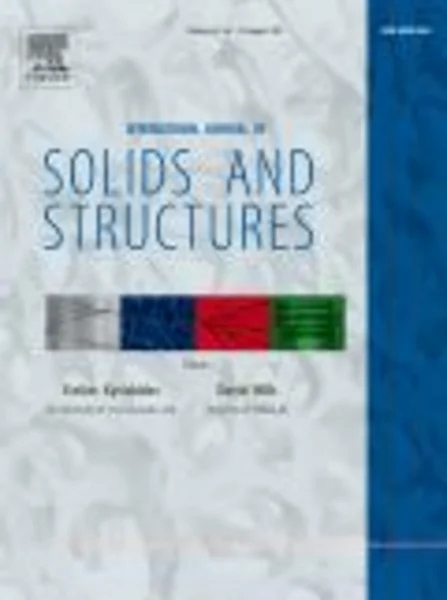-
a finite deformation nonlinear thermo-elastic model that mimics plasticity during monotonic loading
جزئیات بیشتر مقاله- تاریخ ارائه: 1392/01/01
- تاریخ انتشار در تی پی بین: 1392/01/01
- تعداد بازدید: 690
- تعداد پرسش و پاسخ ها: 0
- شماره تماس دبیرخانه رویداد: -
we present and study a nonlinear thermo-elastic constitutive model that under monotonic loading closely reproduces the response seen in plasticity, showing the initial stiff elastic response, kneeing as if yielding, and then showing response resembling post-yield hardening. the proposed large deformation thermo-elastic response model is constructed based on four physically identifiable mechanical parameters, that are closely related to the parameters used to construct plasticity models, thermal expansion parameters and two thermodynamic parameters. the four mechanical parameters are the initial elastic shear and bulk moduli, the yield point in shear, the hardening slope in shear. the thermodynamic parameters are the heat capacity at a reference temperature and its rate of change with changes of temperature. the model can be considered an alternate to deformation plasticity models currently used and, as such, can be used as a lightweight substitute for plasticity modeling in certain analysis. since the proposed model is thermodynamically based, not only thermal effects are integrated into the model, but also the stress is calculated in terms of the applied deformation, allowing the model to be integrated with other models when conducting numerical analysis. we study the response of the proposed model under simple shear, uniaxial extension, confined compression, partially-confined compression, and biaxial extension. we incorporate the elastic model into abaqus using its umat subroutine for solid elements and using uhyper for shell elements. we compare the large deformation response from the proposed elastic model with j2-plasticity, and with plasticity and deformation plasticity models implemented in abaqus. the model in most cases compares very favorably to all such models. this comparison is done for both homogeneous and non-homogeneous problems including the case of a cantilever beam under tip loading. we show that for the problems that it applies to, the models run in approximately one tenth the computational time and with one tenth the number of iterations needed to conduct the analysis using the plasticity model in abaqus.
مقالات جدیدترین رویدادها
-
استفاده از تحلیل اهمیت-عملکرد در ارائه الگوی مدیریت خلاقیت سازمانی و ارائه راهکار جهت بهبود
-
بررسی تاثیر ارزش وجوه نقد مازاد بر ساختار سرمایه شرکت های پذیرفته شده در بورس اوراق بهادار تهران
-
بررسی تأثیر سطح افشای ریسک بر قرارداد بدهی شرکت های پذیرفته شده در بورس اوراق بهادار تهران
-
بررسی تأثیر رتبه بندی اعتباری مبتنی بر مدل امتیاز بازار نوظهور بر نقد شوندگی سهام با تأکید بر خصوصی سازی شرکت ها
-
تأثیر آمیخته بازاریابی پوشاک ایرانی بر تصویر ذهنی مشتری پوشاک ایرانی (هاکوپیان)
-
بررسی رابطه هوش هیجانی با سبک های رهبری تحولی، تبادلی و آزاد گذار مورد مطالعه : بیمارستان های دولتی شهر اهواز
-
جایگاه و نقش فعالی تهای عملی (کارآموزی) در برنامه های درسی رشته های علوم انسانی
-
دل نیارامد به گفتار دروغ (بررسی صدق در مثنوی)
-
تحلیل چندفرکتالی نوسانات روندزدایی شده جریان رودخانه صوفی چای
-
مروری بر استفاده از لایه های تقویت کننده جهت کاهش اثر زلزله در محل های دفن زباله
مقالات جدیدترین ژورنال ها
-
مدیریت و بررسی افسردگی دانش آموزان دختر مقطع متوسطه دوم در دروان کرونا در شهرستان دزفول
-
مدیریت و بررسی خرد سیاسی در اندیشه ی فردوسی در ادب ایران
-
واکاوی و مدیریت توصیفی قلمدان(جاکلیدی)ضریح در موزه آستان قدس رضوی
-
بررسی تاثیر خلاقیت، دانش و انگیزه کارکنان بر پیشنهادات نوآورانه کارکنان ( مورد مطالعه: هتل های 3 و 4 ستاره استان کرمان)
-
بررسی تاثیر کیفیت سیستم های اطلاعاتی بر تصمیم گیری موفق در شرکتهای تولیدی استان اصفهان (مورد مطالعه: مدیران شرکتهای تولیدی استان اصفهان)
-
الگوی پیشنهادی نظام مند برای سیاست گذاری در آموزش و پرورش
-
مطالعه تطبیقی نظریه تقلید در باب هنر از دیدگاه فلسفه غرب و فلاسفه ایرانی اسلامی
-
بهداشت روح، ضرورت و اهمیت آن
-
بررسی رابطه بین عوامل شخصی و سازمانی افراد بر توانمند سازی آنها از دیدگاه روانشناسان
-
evaluation of load-bearing performance of existing cast steel node




سوال خود را در مورد این مقاله مطرح نمایید :